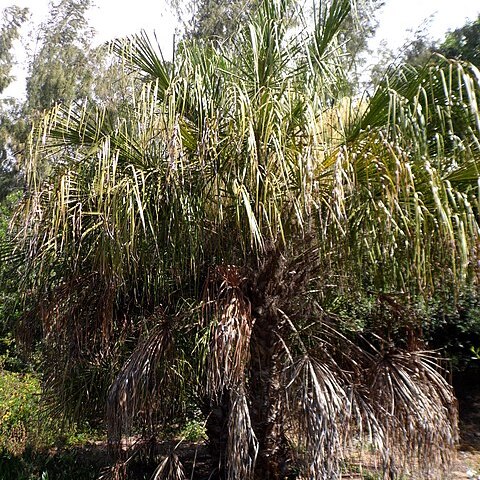Trunk to 20 m tall, 13–30 cm diam., grey; petiole stubs elongate, persistent. Leaves 30–50 in a dense rounded crown; petiole 120–200 cm long, 10–18 mm wide, with sharp thorns on proximal margins; leaf blade circular, 90–160 cm diam., chartaceous, dark green, abaxially glabrous, glossy, divided for c. 1/2 its length; segments 50–80, drooping distally, deeply bifurcate, with acute lobes. Inflorescence 120–210 cm long, branched to 2 orders; bracts with scattered appressed silver scales; rachillae minutely pubescent. Flowers solitary or in sympodial clusters of 2 or 3, tubular, cream to pale yellow; sepals triangular, 0.8–2 mm long, acute, membranous; petals broadly triangular, 1–1.3 mm long, acute, fleshy; stamens c. 1 mm long. Fruit obovoid to pyriform, 9–13 mm long, c. 10 mm diam., purple-black, pruinose. Seed ovoid, 8–9 mm long.
More
An evergreen palm. It grows to 15 m high and spreads to 3 m across. The stem is erect and heavily armed with spines. The trunk is 30-40 cm across. The trunk is grey to black. It has a single stem and fan leaves. It has a densely leafy crown which is rounded and drooping. The leaves are 1-1.5 m long and 1-1.5 m across. They are shiny and dark green. Leaves are divided into narrow segments with strong thorny leaf stalks. The leaf stalks are 1.5 m long. The leaf bases are persistent on the trunk. The flowers are cream or yellow in elongated heads. The flowers are 1-1.2 cm across and the heads can be 2.5 m long. The fruit are berries. They are 1 cm across. They are purple black when ripe. They have a powdery covering. They contain a single hard shelled seed.
A tropical palm. It does best on light to medium soils. It needs moist soils and a protected partly shaded position. It is damaged by drought and frost. It grows naturally on monsoon forest often near streams. It can stand seasonal flooding. In north Queensland it grows from sea level to 100 m altitude. In the Cairns Botanical Gardens.
More
Grows in swamp forests, on alluvial flats, on the leeward side of mangroves and in moist to wet areas in monsoonal thickets and gallery forests.


